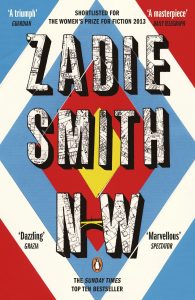The following article is a short essay and review realised as part of a take-home exam for Postromantic Materialism course held at the University of Leuven in 2014-2015.
Like most of Smith’s work, NW engages with the issue of multiculturalism. Read up on this issue and critically discuss Smith’s particular take on it.
Before deepening the issue of multiculturalism, I want to specify some differences about the use of terminology like “multiculturalism” and “interculturalism”. In multiculturalism, differences between people and their cultures are celebrated as positive distinctive features, but seldom arriving to a real exchange between cultures. In intercultural communities, this exchange happens and there an alternation of immersion in different cultures. We cannot say what model is the best in our societies, but we can observe the reality and transpose it into literature for a better understanding. London seems the best example for better explaining these differences: different cultures share the same territory, bur hardly ever they share and exchange something more than the city they live in. The multicultural literature responds to the necessity of explaining the identity of a second generation in a society unaware of its selfishness.
Nw is set in the north-western part of London. The surroundings in this an important part of the notion of multiculturality they talk about:
If you have ever taken a ride back home on a London night bus, from the centre of town to one of the outer boroughs, you will know that it is an experience that can be, by turns, rowdy, lyrical, melancholy, heartwarming and hair raising; […] Reading Zadie Smith’s new novel, “NW”, is very much like getting onto one of those night buses (Shaw, 2013).
The “multicultural novel” in the United Kingdom seems closely related to his capital city, London. Several writers described London from their personal point of view, as immigrants or second generation children living in England and thus projecting their personal lives in the ones of their characters. Zadie Smith was born in Brent, a neighborhood in the North-West of London, to a Jamaican mother and an English father. Her personal life is similar to the lives of other famous “multicultural author” who wrote stories set in London. Monica Ali was born in Bangladesh to a Bangladeshi father and an English mother. In Brick Lane (2003) -name of the street in which mainly lives the Bangladeshi community in London- she tells the story of a Bangladeshi woman moving to London. Stephen Kelman was raised in the Marsh Farm, a social estate in Luton known for its social problems. In 2011 he published Pigeon English, the story of Ghanaian immigrant living in an unaccommodating estate in London. Hanif Kureishi is probably the most famous author of this literary genre. He was born in South London to a Pakistani father and an English mother and he became famous as a novelist with The Buddha of Suburbia (1990) and Something to Tell You (2008). Kureishi states that “questions of race, identity and culture were the major issues post-colonial Europe had to face” (2005). The colonialism is strictly related to the multiculturalism we can fell in London, even in literature. It seems that in contemporary literature we can find a compromise with new possible notions of identity and, in particular, British identities. This leads us to something unexpected, like multicultural literature, taking to another level social differences we used to confront with in colonial literature.
Smith’s novel is not really built with a linear story, presenting suggestions about the lives of four different characters, all united by the sorrow created by the search for their own identity. Throughout her oeuvre, she is engaged with the topics of nationhood, cultural alienation, multiculturalism and post-colonialism. In NW, the protagonists are the example of a post-colonial mixing. The novel opens with a focus on Leah, maybe the most “local” character, but she is keeping out of sight two of the hostile cultures in the British isles: the Irish and the English. From this little clashing identity, people all around her reveal global origins: “her husband [Michel] is half Algerian, half Guadeloupean; her best friend [Natalie] is first-generation Caribbean; and her friend’s husband [Nathan] is the product of a park encounter between a rich Italian woman and a man from Trinidad” (Enright, 2012). Leah seems so attracted by “otherness” that “she lacks room for a substantive self” (Childress Custer, p. 14).
In NW, language is used as a method to disorientate and thus trying to reach a sort of truth, or a conclusion: is multiculturalism leading us to be “liquid strangers”, instead of enriching our personal cultures and identities?
Bibliography
Zadie Smith, NW: a novel, Penguin Books, 2012
Susan Shaw, London: Lost and Found in Zadie Smith’s new novel, published on
18/10/2013 by Jol Press. Consulted on 12/12/2014 at http://www.jolpress.com/zadie-smith-nw-literature-london-multiculturalism-novel-article-822435.html#yHvLWpJFVg4KjwvO.99
Hanif Kureishi, “The carnival of culture”. The Guardian, 04/08/2005. Consulted on
12/12/2014 at http://www.theguardian.com/world/2005/aug/04/religion.uk
Heather Childress Custer, Zadie Smith’s NW: A Compass in Sad Multicultural
Land, University of North Carolina.
Anne Enright, “Mind the Gap. NW by Zadie Smith”. The New York Times,
21/12/2012. Consulted on 12/12/2014 at http://www.nytimes.com/2012/09/23/books/review/nw-by-zadie-smith.html?pagewanted=all&_r=0

